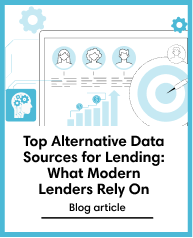Alternative Data
Aug 11, 2020
Analytics for 2020 and Beyond: From Smartphone Metadata to Better Credit Decisions
Subscribe to our newsletter
Up until recently, the financial industry had very rigid criteria to define creditworthiness and the cookie-cutter assessment model left little wiggle room for anyone who had an unconventional or unstable source of income or simply did not have the “right” data to back up their application.
With gig-economy workers, new entrepreneurs and the likes of Gen-Z, who are more credit active than any other “Gens” before them, flooding the credit market businesses have started shifting the way credit analysis is done and how they define a creditworthy applicant.
On the applicant’s side, they are more demanding and impatient than ever before.
The Era of Digital Scorecards
These developments led the way to alternative data being used in addition to traditional data sources to underwrite the applicants.
CredoLab has been leading this change by using non-personal, smartphone metadata to help credit providers complete their underwriting process with greater accuracy. With just a white-label app or a mobile SDK that can be integrated into the lender’s existing app, the AI-based scoring algorithm crunches over 3.8 million features from opt-in smartphone metadata to find the most predictive behavioural patterns before converting them into credit scores.
The scores and the overall insights generated by the AI-engine are sent to the backend dashboard within seconds - speeding up the time-to-yes. In the backend, CredoLab’s analytics dashboard equips the decision-makers with every possible information to predict the willingness of the applicant to repay the credit.
Below are the highlights of what the dashboard covers and how it helps to make better credit decisions.
Artificial Intelligence-Driven Analytics in Action
A combination of giving the status of the data collected and presenting additional insights based on analysis done by the engine makes CredoLab’s analytics dashboard an underwriter’s heaven who wants to look beyond the traditional documents and application form information.
Data Collection Status
A quick look gives the underwriter general information on all the applicants - when was the score generated, what device was used, what permissions were granted, and so on.
How this helps: This gives a detailed view of the quality of the datasets being collected, the propensity of applicants to grant Operating System’s permissions, and the velocity of a device (the number of times the same device has been seen or has applied for a loan). With these insights, the lender can take actions to change the marketing messages, improve the collection of permissions or detect early signals of fraudulent activity.

Evaluation
The Evaluation tab gives a no-frills attached, basic analysis of the application indicating the credit score, the fraud scale, and additional details such as the other lending apps installed in the phone.
How this helps: This is the first check-point in the road to completing the analysis of a particular applicant. For example, the credit risk score and the anti-fraud checks can be used either to directly approve or reject an applicant or re-visit the additional details provided in the application form to offer a variable interest rate to implement a risk-based strategy and improve the overall approval rate.

In-depth Reports and Insights
This section allows you to dive a level deeper into the datasets captured, the break-down by Operating System, device manufacturer, size of the digital footprints, and trended permissions data either dataset by dataset or in an aggregated manner
How this helps: Are they having problems with older versions of the Operating System? What is the distribution of granted and denied permissions over time? Have there been any significant changes and did they concur with, for instance, a new app release or a disservice? This section helps you understand your customers better and helps you serve them better.

Fraud Checks
In addition to analysing the credit scoring, CredoLab’s analytics dashboard also indicates the possible fraudulent applicants from the lot. This is done at various levels to weed out the blatant fraudsters at the very start of the application and the really tricky ones after more in-depth analysis.
How this helps: Has this device been seen in the network? Is it connected with a confirmed fraudulent application? Does the application originate from a risky-location or is the stated IP different from the ‘real’/detected IP address? Did the same device apply for multiple loans at the same time? This section serves as an insurance policy to detect fraudulent attacks and stop applications from customers that you are better off rejecting.

To know more about CredoLab’s analytics dashboard and how you can use it to your benefit, reach out for a one-one free demo.





